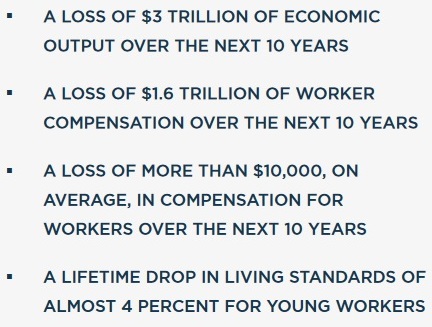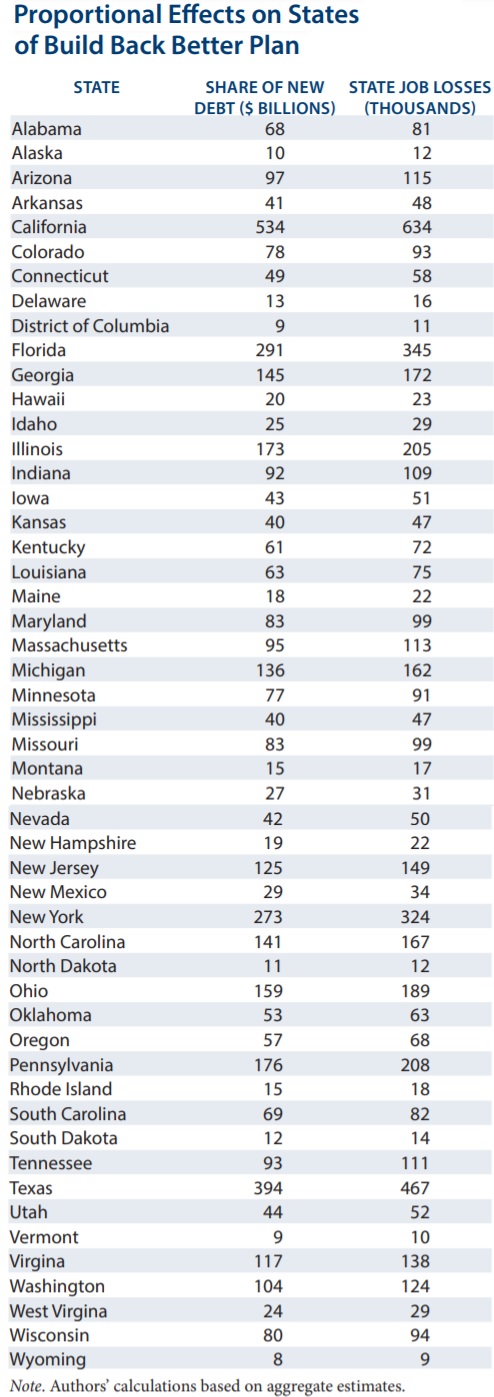President Biden’s fiscal agenda of higher taxes and bigger government is not a recipe for prosperity.
How much will it hurt the economy?
Last month, I shared the results of a new study I wrote with Robert O’Quinn for the Club for Growth Foundation.
 We based our results on a wide range of economic research, especially a scholarly study from the Congressional Budget Office, and found a big drop in economic output, employment and labor income.
We based our results on a wide range of economic research, especially a scholarly study from the Congressional Budget Office, and found a big drop in economic output, employment and labor income.
Most troubling was the estimate of a long-run drop in living standards, which would be especially bad news for young people.
Today, I want to share some different estimates of the potential impact of Biden’s agenda.
A study for the Texas Public Policy Foundation, authored by E. J. Antoni, Vance Ginn, and Stephen Moore, found even higher levels of economic damage. Here are some main excerpts.
President Biden and congressional Democrats seek to spend another $6.2 trillion over the next decade, spread across at least two bills that comprise their “Build Back Better” plan. This plan includes heavy taxing, spending, and debt, which contributes to reducing growth rates for GDP, employment, income, and capital stock. Compared to baseline growth over the next decade, this plan will result in estimated dynamic economic effects of 5.3 million fewer jobs, $3.7 trillion less in GDP, $1.2 trillion less in income, and $4.5 trillion in new debt.
…There are many regulatory changes and transfer payments in current legislation whose effects have not been included in this paper but are worth mentioning in closing since they will have many of the same effects as the tax increases discussed in this paper. Extending or expanding the enhanced Child Tax Credit, Earned Income Tax Credit, Child and Dependent Care Tax Credit, and more, disincentivizes working, reducing incomes, investment, and GDP. Just the changes to these three tax credits alone are expected to cause a loss of 15,000 jobs… Permanently expanding the health insurance premium tax credits would similarly have a negative effect… Regulatory changes subsidizing so-called green energy while increasing tax and regulatory burdens on fossil fuels also result in a less efficient allocation of resources.
If we focus on gross domestic product (GDP), the TPPF estimates a drop in output of $3.7 trillion, which is higher than my study, which showed a drop of about $3 trillion.
Part of the difference is that TPPF looked at the impact of both the so-callled infrastructure spending package and Biden’s so-called Build Back Better plan, while the study for the Club for Growth Foundation only looked at the impact of the latter.
So it makes sense that TPPF would find more aggregate damage.
And part of the difference is that economists rarely agree on anything because there are so many variables and different experts will assign different weights to those variables.
So the purpose of sharing these numbers is not to pretend that any particular study perfectly estimates the effect of Biden’s agenda, but rather to simply get a sense of the likely magnitude of the economic damage.
Speaking of economic damage, here’s a table from the TPPF showing state-by-state job losses.
I’ll close by noting that you can also use common sense to get an idea of what will happen if Biden’s agenda is approved.
He wants to make the United States more like Western Europe’s welfare states, so all we have to do is compare U.S. living standards and economic performance to what’s happening on the other side of the Atlantic Ocean.
And when you do that, the clear takeaway is that it’s crazy to “catch up” to nations that are actually way behind.

[…] At the risk of understatement, the economic consequences of those policies would be unfortunate. […]
[…] from now, I’m guessing he will be like Obama with bad but not horrible results. Yes, Biden has an awful fiscal agenda, but his failed stimulus and the watered-down (and absurdly misnamed) Inflation Reduction Act may […]
[…] now, I’m guessing he will be like Obama with bad but not horrible results. Yes, Biden has an awful fiscal agenda, but his failed stimulus and the watered-down (and absurdly misnamed) Inflation […]
[…] from now, I’m guessing he will be like Obama with bad but not horrible results. Yes, Biden has an awful fiscal agenda, but his failed stimulus and the watered-down (and absurdly misnamed) Inflation Reduction Act may […]
[…] now, I’m guessing he will be like Obama with bad but not horrible results. Yes, Biden has an awful fiscal agenda, but his failed stimulus and the watered-down (and absurdly misnamed) Inflation Reduction Act may […]
[…] on research from the Congressional Budget Office, I’ve shared estimates of the potential economic damage from the fiscal plan Joe Biden unveiled last […]
[…] on research from the Congressional Budget Office, I’ve shared estimates of the potential economic damage from the fiscal plan Joe Biden unveiled last […]
[…] on research from the Congressional Budget Office, I’ve shared estimates of the potential economic damage from the fiscal plan Joe Biden unveiled last […]
[…] when Democrats couldn’t get all 50 of their Senators to support a multi-trillion dollar, growth-sapping expansion in taxes and […]
[…] The Death of (the horribly misnamed) Build Back Better – President Biden somehow decided a very narrow victory over a very unpopular incumbent meant that he had a mandate for a radical expansion of the welfare state, accompanied by a plethora of class-warfare tax increases. Fortunately, Congress did not approve Biden’s growth-sapping plan. […]
[…] The Death of (the horribly misnamed) Build Back Better – President Biden somehow decided a very narrow victory over a very unpopular incumbent meant that he had a mandate for a radical expansion of the welfare state, accompanied by a plethora of class-warfare tax increases. Fortunately, Congress did not approve Biden’s growth-sapping plan. […]
[…] The bad news is that our economy will be much weaker (and our results are in line with other estimates, including those done before the election and since the election). […]
[…] The Economic Damage of Biden’s Fiscal Agenda […]
[…] Most observers are focused on the upset victory for Republicans in Virginia and the huge vote gains for the GOP in New Jersey. And I won’t be upset if those remarkable election results lead my Democratic friends in DC to back away from Biden’s big-government agenda. […]
[…] Most observers are focused on the upset victory for Republicans in Virginia and the huge vote gains for the GOP in New Jersey. And I won’t be upset if those remarkable election results lead my Democratic friends in DC to back away from Biden’s big-government agenda. […]
[…] Most observers are focused on the upset victory for Republicans in Virginia and the huge vote gains for the GOP in New Jersey. And I won’t be upset if those remarkable election results lead my Democratic friends in DC to back away from Biden’s big-government agenda. […]
[…] I also try to be practical. Biden fiscal agenda would be very bad for the United […]
[…] The Economic Damage of Biden’s Fiscal Agenda […]